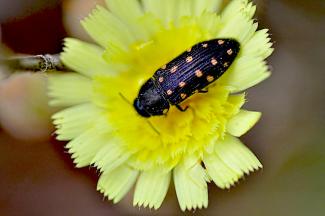
Image Credit: Frayle
Long-horned beetles, metallic wood-borers, click beetles and dascillid beetles (Cerambycidae, Buprestidae, Elateridae, Dascilidae) – herbivores of wood. Many of the largest and prettiest beetles in the PNW are in this ecological guild. Flowers are usually the mating site, and many species live in the deep forest and must migrate for long distances to find appropriate flowers; afterwards they return “home” to lay eggs. The flowers they choose to advertise their presence upon must be large platforms, be attractive and support their weight (i.e., carrot and aster families (Apiaceae, Asteraceae or occasionally mountain lilac Ceanothus or mariposa-lilly Calochortus). Within the forest, they sometimes cluster at dogwood (Cornus) and chinkapin (Castanopsis) inflorescences.



These three longhorned borers belong to the Lepturinae. In general all of the diurnal flower-feeding longhorn beetles are brightly colored have striking designs. They differ from other longhorned beetles with their tapering body shape.



Though most metallic wood-borers are diurnal, the ones frequently flowers are generally characterized with striking designs (the 2 on the right belong to the genus Acmaeodera). On the left is Anthaxia, usually associated with the flowers of herbs under oak trees (primarily buttercup (Ranunculus) and dandelion (Agoseris).



Click-beetles of many kinds are found on flowers, but seldom in high abundance. The dascillid beetle, Dascillus (on the right), was frequently observed on a variety of flowers; its larval biology in the soil is not known.